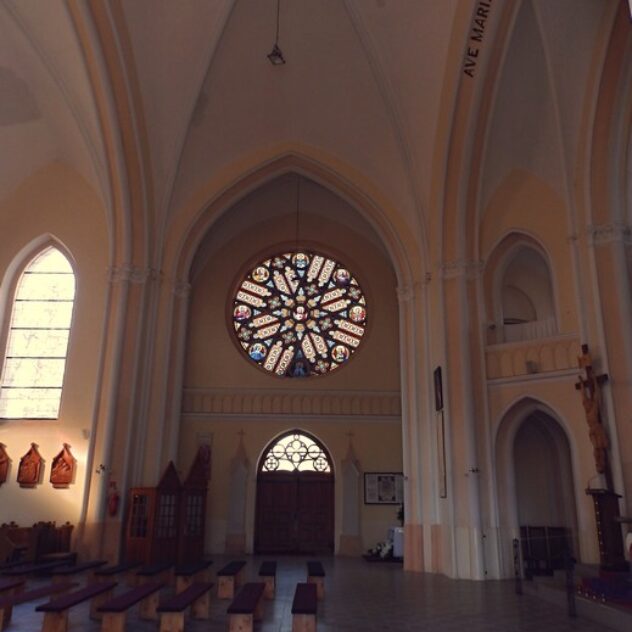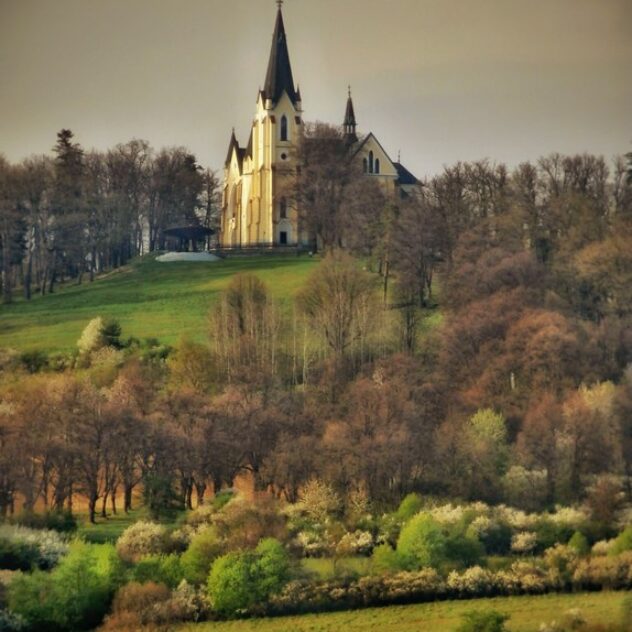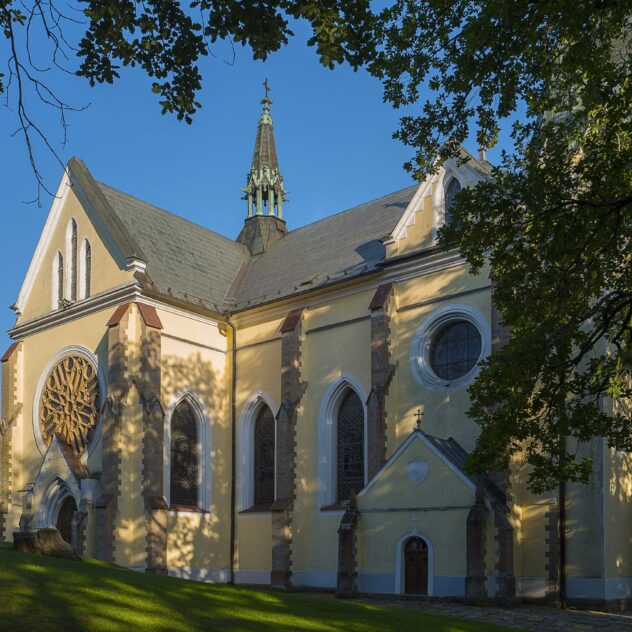Basilica of the Visitation of the Virgin Mary on Marian Mountain in Levoča
Information about the pilgrimage site
The Basilica of the Visitation of the Virgin Mary on Marian Mountain in Levoča has long been one of the most important places of pilgrimage not only in Slovakia but also in Europe. It is the first in Slovakia in terms of the number of pilgrims: during the main pilgrimage, which takes place on the first weekend in July, up to 500,000 pilgrims regularly come here. In Europe, it is one of the top most visited pilgrimage sites dedicated to the Virgin Mary. Since 1984, the pilgrimage church has been elevated to the status of Basilica Minor.
The origins of the tradition of worshipping the Virgin Mary in Levoča date back to the Tartar invasions that took place in our territory in the 13th century. The inhabitants used to hide from the threatening danger on the hill at Levoča, here they were able to defend themselves from the enemy more easily. Out of gratitude to the Virgin Mary for her protection, the first small chapel was built here, which can be considered as a forerunner of today’s Basilica of the Visitation of the Virgin Mary. Shortly afterwards, the Franciscans came to Levoča and introduced the Feast of the Visitation of the Virgin Mary at the beginning of the 14th century. Since ancient times, devotions have been held here every year in the presence of Levoča residents and believers from the surrounding area. The tradition of large pilgrimages involving thousands of believers began in the second half of the 17th century (the period of recatholization in Slovakia) and has been preserved to this day.
Over time, various reconstructions were carried out on the sacral building. As the importance of the place of pilgrimage grew, so did the pilgrimage area. At the end of the 19th century, five chapels with statues were built around the road leading to Marian Hill, depicting the most important events in the life of the Virgin Mary: the meeting of the Virgin Mary with St Anne, the Annunciation, the Virgin and Child, the Immaculate Conception of the Virgin Mary and the Pieta. Trees were also planted around the road to create an avenue. A wooden chapel for the Greek Catholic faithful was also added. The most recent new work is the Stations of the Cross (from 2019), which already leads from the access road to the main field altar and consists of 14 chapels.
Mariánska hora has also always been a place where people have strengthened their faith and human dignity, built the foundations of spiritual and religious life and their national identity. The first steps of one of the three new Slovak bishops, Bishop Ján Vojtaššák, led here in 1922 (today a candidate for beatification), who solemnly consecrated the rebuilt church. The tradition of pilgrimage did not cease even during the harshest years of oppression of religious life – during the communist regime.
The most massive and important pilgrimage in the history of this pilgrimage site took place in 1995 with the personal presence of Pope St. John Paul II, when as many as 650,000 faithful visited the pilgrimage site. Even today, the tradition of pilgrimage to this precious place is very much alive. During the first week of July, many people from near and far travel to the Marian Hill, many walking pilgrimages are organised, but the faithful also come as parish and family communities or as individual pilgrims. The pilgrimage programme is very varied, lasting the whole week of July. In addition to the main pilgrimage, other pilgrimages are organized, such as the pilgrimage of the elderly, the pilgrimage of the disabled, the pilgrimage of seminarians, etc.
Tourist attractions in the vicinity
Town Levoča – Under Mariánská hora is the ancient town of Levoča, which has been a UNESCO World Heritage Site since 2009. It is a cultural and historical pearl among Slovak towns. There are many architectural monuments related to its glorious history. The first written mention of the town dates back to 1249. The biggest driving force behind Levoča’s development in the past was trade. Levoča craftsmen were famous for their products not only in the surrounding area but also throughout Hungary, Poland and even traded with Venice.
Today the town is one of the most visited towns in Slovakia. Among the most precious monuments is the Roman Catholic parish church of St. James from the 14th century, which is dominated by the unique late Gothic wooden main altar of St. James. At 18.6 m high, it is the tallest of its kind in the world. It was made of lime wood and finished in 1517 in the workshop of Master Paul of Levoča. Other important monuments are: the City Monument Reserve, which consists of more than 50 remarkable burgher and patrician houses and is bordered by relatively well-preserved city walls, the town square and also the Levoča Town Hall, which belongs to the top buildings of the secular Renaissance architecture in Slovakia.
Spiš Castle – is one of the largest ruined castle complexes in Central Europe. Spiš Castle and the cultural monuments of the surrounding area were inscribed on the UNESCO World Heritage List in 1993. The oldest written mention of the castle dates back to 1120. Initially, the castle was a border fortress of the Hungarian state. Later it was the main centre of secular power in Spiš. King John I of Hungary was born in the castle. The castle was the birthplace of John the Great of Hungary. A milestone in the history of the castle was the year 1780, when the castle complex was destroyed by fire and Spiš Castle gradually turned into a ruin. The conservation of the castle began only in 1970, when the conservationists started the technically demanding conservation of the walls and palaces threatened by the instability of the bedrock. Today, the castle complex houses museum exhibitions of the Spiš Museum on the history of the castle, medieval weapons and feudal justice. The Sivá Brada – Dreveník nature trail runs through the area around Spiš Castle, focusing on the history of the area as well as natural attractions. The castle is also a popular filming location.
Spišská Kapitula – is a unique religious town, often nicknamed “the little Vatican”. Today it is a part of Spišské Podhradie, but once it was an independent village. The first written mention dates back to 1235. Spišská Kapitula was one of the centres of church education in the territory of today’s Slovakia. The central building of the Chapter is St. Martin’s Cathedral, which forms the centre of the complex. The axis of the entire religious town is formed by the alley of canonical houses, which is also its only street. In the vicinity of the Spišská Kapitula (Pažica locality) there are the remains of the oldest calvary on our territory, which was unveiled in 2002. Interestingly, it is a type of “Calvario Jerusalem”, i.e. the layout of the chapels is reminiscent of Jerusalem in the time of Jesus Christ.
The Hornád gorge – it is one of the most famous tourist attractions of the Slovak Paradise National Park and is considered one of the most beautiful natural areas in Slovakia. The Hornád River has created a canyon-like valley – a narrow abyss, the height of the banks of which can climb up to 150 metres. Various wooden benches are placed all along the route where visitors can stop and rest. There are also several wells with drinking water. In the summer hiking season, this gorge can be reached by boat (single or double-seater boats – kayak, canoe, inflatable boats, paddleboard) in favourable conditions and with plenty of water. There is also a nature trail in the Hornád Gorge with a natural, conservation and historical focus.
The manor house and the Dardanelles summer palace, Markušovce – both of these buildings are tourist and architectural landmarks of the village of Markušovce. They are historical buildings situated in a beautiful French park. The history of the manor dates back to 1643, when the manor was built in the Renaissance style (it was built by František Mariássy) and had a fortress character. Later it was rebuilt in Rococo architectural style (1770 – 1775). At present, a permanent exhibition of historical furniture from the Hodkovce manor house is installed in the manor house and represents the development and type representation of furniture art and interior accessories from the 17th century to the beginning of the 20th century. Near the manor house stands the Dardanelles summer palace, which in the past served for social and representative purposes. Today, the summer palace is an important monument of Rococo architecture and serves as a museum of musical instruments, which focuses on domestic producers and is the only one of its kind in Slovakia.
Other tourist attractions can be found on the website:
Regional Tourism Organisation North-East of Slovakia https://www.severovychod.sk/en
Regional Tourism Organisation Belianske Tatry – Spiš – Pieniny https://www.tatryspispieniny.sk/en/
Levoča Information Office http://ik.levoca.eu/
Accommodation
Accommodation for pilgrims: pilgrimage and exorcism house, located in the pilgrimage area, it is necessary to contact the person in charge, the contact is on the website of the parish of Levoča: https://www.farnostlevoca.sk/kontakt/
Other private accommodation in Levoca or in the surrounding villages.
Availability
By car
Access to the town of Levoca is the fastest by car. The town of Levoca is located near the D1 motorway (exit Levoca). There are several parking lots for cars and buses around the Basilica, but the road to the Basilica is narrow. There is also a car park at the foot of the mountain on the outskirts of the town and it has a rather lower capacity.
By public transport
The bus station is about 4 kilometres from the Basilica. In case of travelling by public transport, the best connection is to take the train to Spišská Nová Ves and here change to a bus in the direction of Levoča. During the season (April – October) there is a bus line from the bus station in Levoča to the Basilica (on Sundays, the first Saturday of the month and during religious holidays). During the summer season, trains may occasionally run from Spišská Nová Ves to Levoča. Passengers can check the timetable on the website www.cp.sk. Long-distance lines also run sporadically to Levoča.
On foot
Walking pilgrimages take place especially before the Feast of the Visitation of the Virgin Mary (the first Sunday in July) from near and far. There are several marked hiking trails leading here, as well as the St. James Way and the St. Mary’s Way. The hiking trails are very well marked and can be found on almost all hiking maps.
On a bicycle
It is possible to ascend Marianska hora from Levoča by bicycle, but it is necessary to take into account the higher difficulty of the terrain. Cycling routes are well marked on almost all tourist maps.








